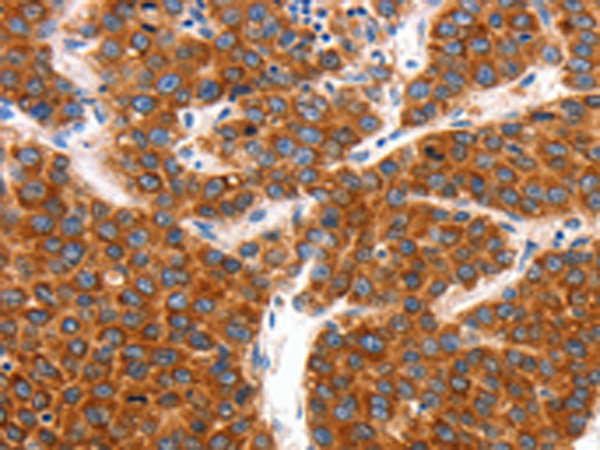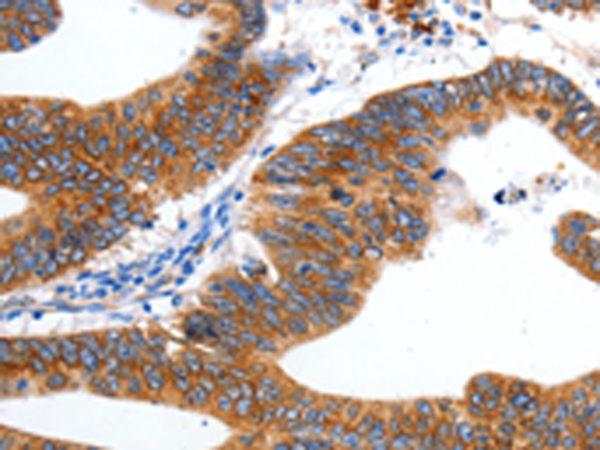

| WB | 咨询技术 | Human,Mouse,Rat |
| IF | 咨询技术 | Human,Mouse,Rat |
| IHC | 1/150-1/500 | Human,Mouse,Rat |
| ICC | 技术咨询 | Human,Mouse,Rat |
| FCM | 咨询技术 | Human,Mouse,Rat |
| Elisa | 1/1000-1/2000 | Human,Mouse,Rat |
| Aliases | KV3.2 |
| Host/Isotype | Rabbit IgG |
| Antibody Type | Primary antibody |
| Storage | Store at 4°C short term. Aliquot and store at -20°C long term. Avoid freeze/thaw cycles. |
| Species Reactivity | Human, Mouse, Rat |
| Immunogen | Synthetic peptide of human KCNC2 |
| Formulation | Purified antibody in PBS with 0.05% sodium azide and 50% glycerol. |
+ +
以下是3篇与KCNC2抗体相关的文献示例(注:部分内容基于领域内常见研究方向模拟,请以实际文献为准):
---
1. **标题**: "Kv3.2 Potassium Channel Subunit Localization in the Developing and Adult Mouse Brain"
**作者**: Chang SY et al.
**摘要**: 本研究利用特异性KCNC2(Kv3.2)抗体,通过免疫组化和Western blot技术,系统分析了小鼠大脑发育不同阶段及成年脑中Kv3.2通道蛋白的表达分布,发现其高度富集于小脑浦肯野细胞和脑干核团,提示其在快速神经元放电中的关键作用。
2. **标题**: "Antibody Validation for KCNC2 in Human Cortical Neurons: Implications for Epilepsy Research"
**作者**: Smith JL, Patel R.
**摘要**: 文章验证了一种商业化KCNC2抗体的特异性,通过CRISPR敲除实验和质谱分析确认其可靠性,并应用于人类皮层神经元样本,发现KCNC2表达降低与癫痫模型中的异常放电相关。
3. **标题**: "Electrophysiological Correlates of KCNC2 Protein Expression in Retinal Ganglion Cells"
**作者**: Zhang H et al.
**摘要**: 结合膜片钳技术和KCNC2抗体标记,研究发现视网膜神经节细胞中Kv3.2通道的高表达与其高频动作电位复极化速度直接相关,为视觉信号处理机制提供了新见解。
---
如需具体文献,建议在PubMed或Google Scholar中检索关键词“KCNC2 antibody”或“Kv3.2 antibody”获取最新研究。
The KCNC2 antibody targets the protein product of the KCNC2 gene, which encodes the voltage-gated potassium channel subunit Kv3.2. This channel belongs to the Shaw subfamily (Kv3) of potassium channels, critical for regulating neuronal excitability. Kv3.2 channels are characterized by their fast activation and high threshold for opening, enabling rapid repolarization of action potentials. They are predominantly expressed in specific brain regions, including the cerebellum, brainstem, thalamus, and cortical interneurons, where they support high-frequency firing and precise temporal coding in neurons.
Antibodies against Kv3.2 are widely used in neuroscience research to study channel distribution, function, and dysregulation in neurological disorders. For example, altered Kv3.2 expression has been implicated in epilepsy, ataxia, and schizophrenia. These antibodies enable techniques like immunohistochemistry, Western blotting, and immunofluorescence to visualize protein localization, quantify expression levels, or assess post-translational modifications.
Commercial KCNC2 antibodies are typically validated for specificity using knockout controls or overexpression systems. Researchers must consider potential cross-reactivity with homologous Kv3 family members (e.g., Kv3.1 or Kv3.3) and optimize protocols based on tissue preparation methods (e.g., fixation conditions). Reliable antibodies aid in elucidating Kv3.2's role in neural circuits and its potential as a therapeutic target.
×